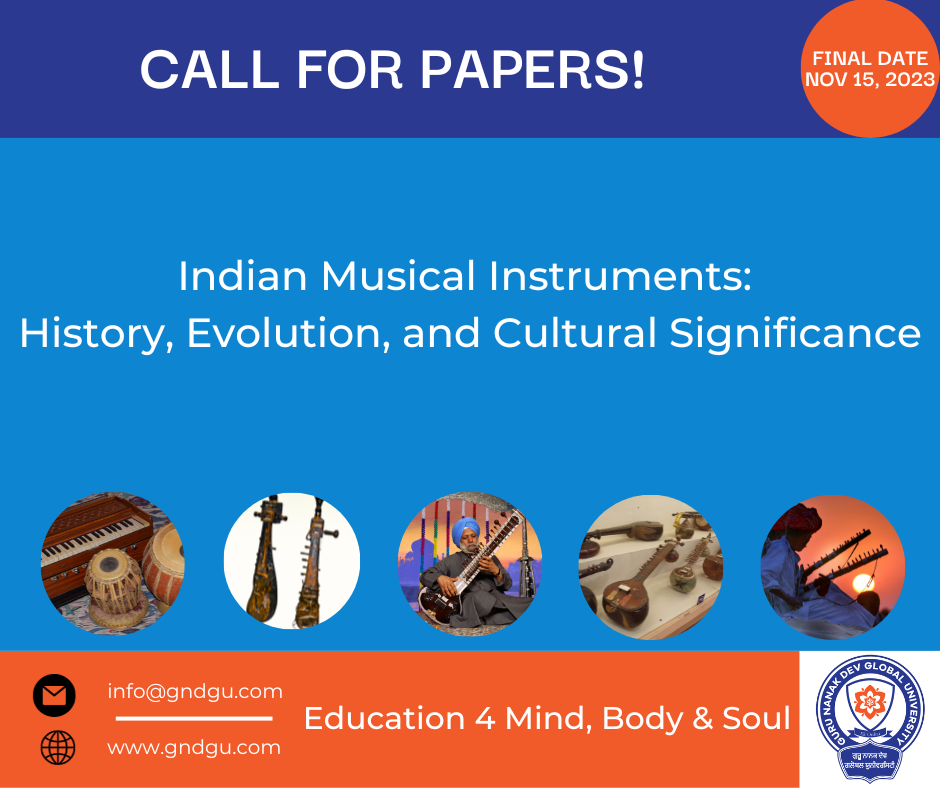Your cart is currently empty!
Call for Papers – Indian Musical Instruments: History, Evolution, and Cultural Significance

Introduction:
The harmonious melodies of Indian music have resonated through millennia, captivating hearts and transcending boundaries. At the core of this musical tradition lie a diverse array of instruments, each with its unique voice and cultural significance. We invite scholars, researchers, musicians, and enthusiasts to contribute to our upcoming publication that delves into the enchanting world of “Indian Musical Instruments: History, Evolution, and Cultural Significance.”
Submission Guidelines:
Full Paper: Submit a maximum 5000 words paper by November 15th, 2023.
Presentation: Authors of accepted papers will present their work at our online conference.
Language: Please submit your papers in English
How to Submit:
You can also send your papers to us via email at pulse@gndgu.com before the submission deadline of November 15th 2023 submission deadline. Include your name, affiliation, contact information, and a brief bio.
List of some prominent Indian musical instruments:
String Instruments:
- Sitar: A plucked string instrument known for its intricate melodies, commonly used in classical music.
- Veena: An ancient string instrument with various regional variations like the Rudra Veena and Saraswati Veena.
- Sarod: A fretless string instrument known for its deep, resonant sound.
- Violin: Used extensively in Carnatic music, the Indian violin is similar to its Western counterpart but played differently.
- Tanpura: A drone instrument used to provide a continuous harmonic background for other instruments.
- Esraj: A bowed string instrument with a melodious sound, used in Sikh and Sufi music.
Wind Instruments:
- Flute (Bansuri): A bamboo wind instrument, often associated with Lord Krishna and used in classical and devotional music.
- Shehnai: A double-reed instrument used in North Indian classical music and often played at weddings.
- Harmonium: A keyboard instrument that provides melodic and harmonic support in various musical genres.
- Nadaswaram: A South Indian wind instrument often played in temples and traditional ceremonies.
Percussion Instruments:
- Mridangam: A South Indian percussion instrument used in Carnatic music, known for its rhythmic complexity.
- Dholak: A double-headed hand drum used in folk and classical music.
- Pakhawaj: A barrel-shaped drum used in the dhrupad style of classical music.
- Ghatam: A clay pot used as a percussion instrument in South Indian music.
- Tabla: A pair of hand-played drums with a wide range of rhythmic possibilities, essential in Indian classical music.
Plucked Instruments:
- Bansuri: A bamboo flute often used in North Indian classical music.
- Rabab: A plucked instrument with a resonator covered with skin, used in traditional and folk music.
Other Instruments:
- Dhol: A large double-headed drum often used in Punjabi music and celebrations.
- Ektara: A one-string instrument, common in folk and devotional music.
- Santoor: A trapezoid-shaped instrument played with mallets, used in classical music.
- Morsing (Jaw Harp): A small, metal instrument played by vibrating a metal or bamboo reed.
- Kanjira: A small frame drum with a tambourine-like jingle used in Carnatic music.
Importance:
Indian musical instruments are not just tools of artistry; they are gateways to India’s rich history, spirituality, and cultural heritage. The instruments embody the soul of Indian classical music, rendering it impossible to separate the music from the instruments that create it. Understanding the history, evolution, and cultural context of these instruments is pivotal in preserving and appreciating the invaluable legacy they represent.
Themes and Topics:
This call for papers invites contributions on a wide range of themes and topics, including but not limited to:
- Historical Significance and Evolution: Explore the historical journey and transformation of Indian musical instruments over the ages.
- Diversity and Types: Examine the vast spectrum of instruments, from stringed to wind to percussion, and their regional variations.
- Cultural Significance and Use: Uncover the role of these instruments in India’s diverse cultures, rituals, and ceremonies.
- Instruments in Different Music Traditions: Investigate how Indian musical instruments have influenced or integrated into global musical traditions.
- Integration into Ragas and Compositions: Analyze the intricate relationship between instruments and classical compositions.
- Contemporary Use and Innovations: Discuss how these instruments have evolved to meet the demands of modern music while preserving tradition.
- Challenges and Preservation Efforts: Highlight the challenges in preserving traditional craftsmanship and the initiatives to safeguard these instruments.
Join us in this enriching journey as we explore the timeless melodies and stories behind Indian musical instruments. Through your contributions, we aim to create a comprehensive resource that not only celebrates these instruments but also ensures their legacy lives on for generations to come.
For any further information, please contact Mr. Baljit Singh via email pulse@gndgu.com